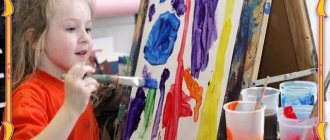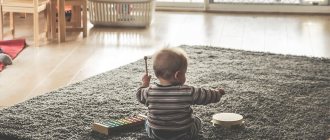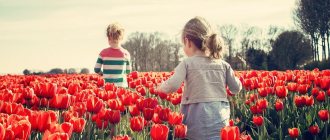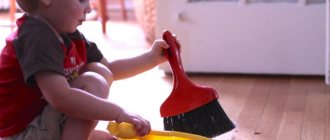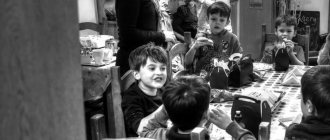Means and methods of aesthetic education in the system of preschool educational organization
Korneva Tatyana Aleksandrovna Migaleva Marina Vladimirovna teachers MBDOU DS No. 72 “Watercolor”
The concept of “aesthetic education” is closely related to the term aesthetics. Aesthetics (from the Greek aisthetiris - sentient, related to sensory perception) is the science of the most general laws of aesthetic, including artistic, human mastery of reality. [4, p.105].
According to scientists, nature is a powerful means of aesthetic education. It is in nature that one can see harmony - the basis of beauty: a variety of colors, shapes, sounds in their combination. Nature itself is a condition for the comprehensive education and development of a child. It becomes a means when an adult purposefully uses its “educational potential” and makes it visible to the child.
The teacher reveals the natural world to children and helps them see it. You just need to see this beauty for yourself and find words that are accessible to the heart of a child. Works of art about nature will provide him with invaluable help in this, which he must know well and skillfully use. In education using the means of nature, it is necessary not only a passive contemplative, but also an effective principle (to protect nature, to help it).
Social life, the work of people with whom the child constantly encounters, is also an important means of aesthetic education. The well-coordinated work of builders makes children want to create a good building, act together, and be attentive to each other. Descriptions of the work of sailors, pilots, teachers, and doctors not only introduce preschoolers to these professions, but also make them want to imitate them. All this is reflected in their games and contributes to the education of moral and aesthetic feelings. [3, p. 157-162]
A multifaceted and inexhaustible means of aesthetic education is art: fine art, music, literature, architecture, theater, cinema. The early introduction of children to real high art contributes to the emergence in the child’s soul of a truly aesthetic perception of reality. Many scientists note that each type of art reflects life in its own way and has its own special impact on the mind and feelings of a child.
Advertising message
Another, no less important, means of aesthetic education is the artistic activity of preschoolers, both organized by the teacher and independent. Fine art is necessary for a child. It gives him rich visual images.
All of the above-mentioned means of aesthetic education - everyday life, nature, art, activity - are effective both on their own and in conjunction, but oversaturation is just as harmful to development as a lack of emotional impact. We must search and find the golden mean.
Having studied the most effective means of aesthetic education in a preschool educational organization, we will move on to studying the methods of aesthetic education.
A method is a way to achieve a goal, a way to solve problems [3, p. 32-39].
Methods of aesthetic education are very diverse. They depend on many conditions: the volume and quality of artistic information, forms of organization and types of activities, and the age of the child. The level of training, skill and abilities of the teacher play a significant role.
A child receives aesthetic information through many channels (social environment, objective world, natural phenomena, works of art). Based on how children receive aesthetic information, methods of aesthetic education can be divided: visual and verbal. Methods also change depending on the forms of organization of activities. During art classes, the teacher gives precise instructions, shows or invites the children to find performance techniques themselves. In practice, methods are used to develop observation skills, independent actions, planning one’s activities and implementing plans. Depending on the age, level of preparedness, growth of individual needs and aspirations of the children, the methods become more complicated.
It should be noted that there are many components that determine the nature of aesthetic education methods. It is difficult to accurately classify them, since they always exist in close connection with others. [5, p. 13-18]
Pedagogical science and practice determine a number of the most effective methods that contribute to the formation of children’s aesthetic feelings, attitudes, judgments, assessments, and practical actions: – the method of persuasion, aimed at developing aesthetic perception, appreciation, and initial manifestations of taste;
- training method, exercises in practical actions designed to transform the environment and develop skills of a culture of behavior;
- method of problem situations that encourage creative and practical actions;
- a method of inducing empathy, emotionally positive responsiveness to the beautiful, and a negative attitude towards the ugly in the world around us [5, p. 87-92].
The peculiarity of the method of persuasion in relation to aesthetic education is that it can be used only when the perceived phenomenon is beautiful. An emotional response occurs in a child when he comes into direct contact with works of art and when he participates in public celebrations. This method can be considered both a visual and verbal method, since any observation of children is accompanied by a simultaneous or subsequent comment from the teacher, awakening the child’s feelings and thoughts.
Systematic exercises in artistic activities and feasible participation in the practice of transforming the immediate environment deepen the activity of children. The method of training and exercise requires repeated repetition. It is used in various conditions. Changing situations helps the child use the acquired skills and strive for further improvement. Repeated exercises in changing conditions allow you to more successfully achieve the desired results. It is important to know that persuasion and training methods do not exist in isolation. Convincing the child of the importance of good deeds, the teacher repeatedly returns to this, as if accustoming children to them.
Thus, the means and methods of aesthetic education we consider in the article in a preschool educational organization help awaken in children a sense of beauty, a desire to act according to their own, childish, but laws of beauty. At the present stage, these means and methods are effective and contribute to the formation of aesthetic feelings, attitudes, judgments, assessments, and practical actions in children.
In general, only a set of methods and means can provide a complete aesthetic education of a child.
Bibliography:
- Barysheva T.A. Empathy and music perception. Interaction of arts in the pedagogical process. – M.: Infra-M, 2000.
- Bolotina L.R. Preschool pedagogy. Textbook / L.R. Bolotina, T.S. Komarova, S.P. Baranova. – Academic project 2005 – 240 p.
- Vendrova T.E., Pisareva I.V. Education with music. – M.: 1991 – 50 p.
- Gogoberidze A.G. Theory and methods of musical education of preschool children. – M.: Publishing House, 2005. – 320 p.
- Kovalitskaya L.M. Methodology for developing skills in visual arts in preschool educational institutions. – Publisher: Arkti, 2008 – 74 p.
Participation – full-time
Section 1. “Methods and techniques for organizing search and research activities of preschool children”
Question 1 AESTHETIC EDUCATION OF PRESCHOOL CHILDREN
Aesthetic education is a purposeful, systematic process of influencing a child’s personality in order to develop his ability to see the beauty of the world around him, art, and create it. It starts from the first years of children's lives.
Aesthetic education is a very broad concept. It includes the education of an aesthetic attitude towards nature, work, social life, everyday life, and art.
Aesthetic emotion is the highest stage in the development of human sensuality in its effective direct manifestation. This is an emotional reaction that reflects the level of a person’s spiritual life, his idea of what is desirable and practical both in the present and in the future. By the aesthetic emotional reactions of a child, one can judge the success or failure of the aesthetic development of the child being raised. Aesthetic emotions influence the development of such human creative abilities as reconstructive creative imagination and fantasy. As a result of the action of an aesthetic emotion, an aesthetic experience is born - a specific / mental state of the body caused by a certain system of emotional-aesthetic / experiences that are impossible outside of personal meaning.
Aesthetic feeling is a socially determined subjective emotional experience, born of a person’s evaluative attitude towards a phenomenon or object. ;
Aesthetic need is one of the fundamental needs of the individual, an internal motivator.
However, the knowledge of art is so multifaceted and unique that it stands out from the general system of aesthetic education as a special part of it. Raising children through art is the subject of artistic education. Acquaintance with beauty in life and art not only educates the child’s mind and feelings, but also contributes to the development of imagination and fantasy.
In the process of implementing aesthetic education, it is necessary to solve the following tasks: systematically develop aesthetic perception, aesthetic feelings and ideas of children, their artistic and creative abilities, and form the foundations of aesthetic taste.
Development of aesthetic perception, feelings and ideas of children.
From the first years of life, a child unconsciously reaches out to everything bright and attractive, rejoices in shiny toys, colorful flowers and objects. All this gives him a feeling of pleasure and interest. The word “beautiful” enters children’s lives early. From the first year of life, they hear a song, a fairy tale, look at pictures; simultaneously with reality, art becomes the source of their joyful experiences. In the process of aesthetic education, they undergo a transition from an unconscious response to everything bright and beautiful to a conscious perception of beauty; the aesthetic perception of reality has its own characteristics. The main thing for him is the sensory form of things - their color, shape, sound. Therefore, its development requires a large sensory culture.
Beauty is perceived by a child as a unity of form and content. Form is expressed in a combination of sounds, colors, lines. However, perception becomes aesthetic only when it is emotionally colored and associated with a certain attitude towards it. Aesthetic perception is inextricably linked with feelings and experiences. A feature of aesthetic feelings is disinterested joy, a bright emotional excitement that arises from meeting the beautiful.
The teacher must lead the child from the perception of beauty, emotional response to it, to understanding, the formation of aesthetic ideas, judgments, and evaluations.
Development of artistic and creative abilities of children Preschoolers have access to almost all types of artistic activities - writing stories, inventing poems, singing, drawing, modeling. Naturally, they have great originality, which is expressed in the direct reflection of reality, faith in the truthfulness of what is depicted, in the lack of concern for viewers and listeners.
/ The uniqueness of children’s creativity lies in the fact that it is based on imitation,
It is widely reflected in the play activities of children - the figurative realization of their impressions of the surrounding world^__
It is in play that the creativity of preschoolers first manifests itself. A game that arises on the initiative of children is characterized by the presence of a plan. At first it is still unstable, one plot gives way to another; The older the children, the more complete and focused the plan becomes.
A role-playing game is characterized not only by the presence of a plan in choosing and defining a theme and plot, but also by creative imagination in their implementation.
The creative imagination of children is also manifested in the fact that they often deliberately combine different plots for their games: they take material from fairy tales, stories, from life, from television and theatrical productions.
Just as in play, children's creativity manifests itself in other types of their artistic activities. In drawing, modeling, stories, songs, the child satisfies his need for an effective, figurative expression of his impressions.
Thus, in the preschool age, the sprouts of creativity are observed, which are manifested in the development of the ability to create a plan and its implementation, in the ability to combine one’s knowledge and ideas, in the sincere transmission of thoughts, feelings, and experiences. — ^ Formation of the foundations of aesthetic taste.
By instilling in children the basics of aesthetic taste, we teach them to see and feel the beauty of their surroundings, and to cherish it. It is better to keep a flower in a flowerbed, but in order for it to bloom and bring joy to others, it must be looked after. Cleanliness in the group, which creates comfort and beauty, must be maintained, not littering, and putting away toys and books. Thus, in the process of education and training, the tasks of aesthetic education in preschool age are carried out.
Basic means of aesthetic education
Aesthetic education of children is carried out through familiarization with the aesthetics of everyday life, with beauty in work, nature, social phenomena and the means of art. Teaching a child to feel and understand the beauty of life is a big and difficult task that requires long-term work by adults.
The aesthetics of everyday life in a kindergarten is manifested in artistic simplicity, in a thoughtful selection of household items, where each thing has its own place, where there is nothing superfluous.
Requirements for the design of a kindergarten are determined by the tasks of protecting the life and health of children and the content of educational work with them:
1. Expediency, practical justification of the situation.
2. Purity, simplicity, beauty.
3. The right combination of color and light, creating visual contrast that ensures the visibility of each object.
4. All design components must form a single ensemble. From the first years of life, children must be taught the aesthetics of appearance combined with a culture of behavior. In this regard, one of the strongest means of influence is the example of the teacher himself.
Native nature is a powerful means of aesthetic education. The teacher reveals to the children the world of nature, helps them see its beauty in a drop of dew on a bud, and in the interweaving of grass, and in the colors of the sunset... You just need to see this beauty for yourself and find words accessible to the child’s heart, from
Social life and the work of people with whom the child constantly encounters are also important means of aesthetic education. Streets, buildings, monuments also contribute to the aesthetic and moral education of children. Art is a multifaceted and inexhaustible means of aesthetic education. It introduces children to the life of the whole country, fosters love for the Motherland, its honest, kind and courageous people. Works of art are a rich source of joy, aesthetic pleasure, and spiritual enrichment. Many types of it are available to children: literature, music, painting, theater, cinema.
/ The condition and means of aesthetic education is the artistic activity of preschool children, both organized by the teacher and independent. Artistic activity is called when it is directly related to the arts: theatrical games, verbal artistic creativity, music playing, visual and decorative applied practice, design.
Methods of aesthetic education.
Showing as a method of education is used during initial acquaintance with the subject of aesthetic reality. When using these methods, it is very important that the teacher can show children his feelings, his attitude, and knows how to express feelings.
Expressiveness of intonation when reading a poem, sincere admiration for a beautiful
things, genuine grief when encountering negligence in clothing, sloppiness, a bright and emotional expression of one’s feelings by adults serve as active methods of influencing a child, because rely on a feature of childhood - imitation.
/ Practical methods: demonstration, exercise, explanation, method of search situations (the desire to create with your own hands: sculpt, draw, craft, decorate, participate in various types of artistic activities).
Forms of organization
| According to control principle | Under direct supervision | Under indirect |
| children's activities | adult | adult guidance |
| By combining method | Cooperative activity | Individual, |
| children | children and adults: • frontal • in groups • with one child | subgroups |
| By type of activity | Classes, excursions, | Theatrical games |
| holidays, games, | repetition of classes, | |
| entertainment, work | holidays. |
No. 2 Aesthetic perception
From the first days of his life, a child finds himself in a world of unknown and unusual phenomena, under the influence of which his brain and psyche come into an active state. Acquaintance with the outside world begins. Already in the first month of life, the child has a selective emotional reaction to external events. At the moment of manifestation of primary needs, the newborn does not have even the most basic images and ideas, but already in the first year of life the child develops cognitive and emotional reactions. According to physiology, a child’s brain matures faster if he is involved in orientation activities and provided with various toys. The thirst for new experiences constantly develops into a cognitive need, which is differentiated into an aesthetic one. Objective activity introduces the child into the world of an unknown measure of human life. It gives the first ideas about the form (through line, color, sound) and content (through meaning) of an object, forms, organizes its visual and auditory perceptions, and through them the ability to distinguish the features of objects.
Thus, already in the preschool period, the initial elements are formed, which will subsequently form the structure of aesthetic needs.
Preschool age is the stage of accumulation of initial information: the child develops the first skills of aesthetic perception and activity, and the foundations of aesthetic culture are formed. But the object does not yet become a source of aesthetic knowledge; it serves more as a source of direct expression of feelings.
“A child turns to a drawing or a book, a song or a fairy tale not because he sees their aesthetic significance. He is guided by cognitive interest, curiosity, inquisitiveness; he has no connection between the goal and the method of action. His attitude towards the aesthetic manifestation of reality accessible to him is unstable. The child is introduced to the world of books, colors, music, before he develops any form of aesthetic attitude towards reality. By involving the child in visual arts and music classes, the teacher helps to activate thinking, sharpens interest, and determines his selectivity; From systematic and targeted exercises, the child develops the organs of vision, touch, and taste. But this age is plastic and unstable, which is why most often there are random manifestations of desires and interests.
Therefore, the educator has a serious responsibility for the selection and organization of means, external factors, for the formation of a purposeful, sustainable, aesthetically meaningful appearance of the individual.
3 QUESTION Development of a plan for a lecture lesson on pedagogical and psychological
The essence of aesthetic education
Definition 1
Aesthetic education is a specially organized pedagogical process aimed at forming and developing in a child the ability to see, perceive and appreciate beauty in art, nature and everyday life.
Aesthetic education also means the formation of a child’s aesthetic culture and aesthetic taste. At the same time, it is necessary to pay attention to the fact that the process of aesthetic education is connected with other areas of education (labor, political, moral, physical, etc.).
Note 1
The goal of aesthetic education is to reveal in a child the inclinations laid down by nature for the formation of creative abilities to create objects of art according to the canons of beauty.
Are you an expert in this subject area? We invite you to become the author of the Directory Working Conditions
Achieving this goal is possible only if harmony is established between all aspects of the child’s personality, and he is in complete agreement with himself.
Objectives of aesthetic education:
- Systematic and purposeful development in children of the ability to perceive and realize beauty, to experience aesthetic feelings. Children should not only see and feel beauty in its various manifestations, it should evoke in them emotional responsiveness, joy from contemplation, admiration, excitement and passion.
- Introducing children to a variety of activities in the field of art, fostering the habit and need to introduce feasible elements of beauty into the environment, their everyday life and appearance, and also ensure that their behavior complies with generally accepted aesthetic standards.
- Form and develop the ability to evaluate various works of art and life phenomena. Be able to not only evaluate, but express your thoughts and feelings in words, while fully mastering aesthetic terms.
- To develop children's artistic and creative abilities in various fields of activity (music, labor, drawing, modeling, etc.).
Finished works on a similar topic
Course work Aesthetic education as an object of research 420 ₽ Abstract Aesthetic education as an object of research 280 ₽ Test work Aesthetic education as an object of research 200 ₽
Receive completed work or specialist advice on your educational project Find out the cost
One of the main tasks of aesthetic education is to develop a child’s creative attitude towards the surrounding reality.
In the process of aesthetic education, children develop creative abilities, the ability to think creatively, fantasize, dream, see beauty and experience positive emotions.
Note 2
Thus, the essence of aesthetic education lies in the development of artistic and aesthetic abilities in children, as well as their involvement in creative activities.
